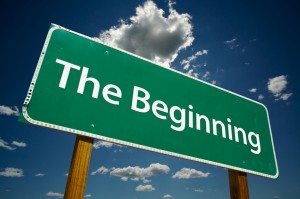In the Beginning…
 The most important part of your novel, short story, or even nonfiction piece is the beginning.
The most important part of your novel, short story, or even nonfiction piece is the beginning.
What compels the reader to keep reading? How do you craft a beginning that doesn’t bog down, one that keeps the reader engaged?
There are several schools of thought regarding beginnings. Depending on the genre, the beginning can create a normal world (think of the movies Star Wars or The Wizard of Oz), and let the reader get to know the characters in their natural habitat. Women’s fiction and literary fiction tend to follow this style. Caution: Choose the details of the everyday life carefully, to the point of foreshadowing what’s going to come next—namely conflict. What’s at stake for the main character? In Star Wars, Han Solo saw his family facing the loss of their way of life, and peace. Dorothy, in The Wizard of Oz, engaged in a life or death battle to keep Toto.
What we tend to remember in these stories is the outrageous intergalactic characters and battle scenes of Star Wars or the Technicolor adventures on the way to Oz. Yet when one analyzes the story structure, the “black and white” ordinary life is where the story begins—and presages the main conflict in a way that amplifies the conflict when it arrives.
A different way to begin a story, common especially in suspenses, is in media res, which throws the reader into the deep end of the swimming pool along with the main character. Picture a book beginning with a young woman being snatched from a sidewalk and shoved into a van. The van speeds off—and of course the reader is going to turn the page to find out who, why, where, and what happens next??? This technique can be very effective. The author gives concise clues to setting (city or suburb, day or night, good neighborhood vs bad, etc.), characterization (she fights back or is paralyzed with fear, the snatcher and snatchee know each other and have shared history, etc.), and motivation (kidnapping vs bodyguards collecting an errant charge vs fraternity joke, etc.) without much else in the way of detail to ground the reader. It’s not for every story, though; imagine Dorothy opening the door of the house after setting down in Oz, with the story beginning in Technicolor. The event would lose much of its impact, and the subsequent conflict would lose its sizzle.
One of the most common mistakes new writers make is starting the story in the wrong place. My advice is to write it the way that makes sense to you, then come back when you’ve finished the whole thing and re-read the beginning. Chances are you’ll hit a certain paragraph where everything springs to life. That’s where your story really begins. One common suggestion is to dump the first chapter and start with the second. Personal experience: I had to dump the first three chapters of my first novel—they were that boring, even to me! But I had to write them in order to discover where the story really began. You may have to cut words, but they are never wasted; you always learn something important about your characters, even if it doesn’t end up as words in the book.
Another common mistake is to explain the characters and back story (what happened before the book started). This is called an information dump. Resist. Draw your characters clearly through their internal and present thoughts; let the reader get to know them deeply, layer by layer. What brought them to this point will be revealed in good time. Another wise bit of advice I’ve come across is to get about thirty pages into a story before disclosing back story.
Dialogue is a great way to tell a story, and the beginning is no exception. If you can incorporate dialogue at that point, do so, and make it unforgettable.
For a fun exercise, go to the library or a bookstore, or even your own shelf of well-worn favorites. Open to the first page and read the first line. Is it compelling? Intriguing? Why did you want to read more? How much information about the character, setting, motivations and tone did the author convey in those few words?
When it comes down to it, the story begins when there is a change in the main character’s life. The change can be subtle or cataclysmic, but that is the point at which you, as author, commence weaving a tale that will hold readers in thrall until the words The End.
How do you know where your book begins? Do you have a strategy for determining what the opening scene is, or who inhabits it? Please share!



